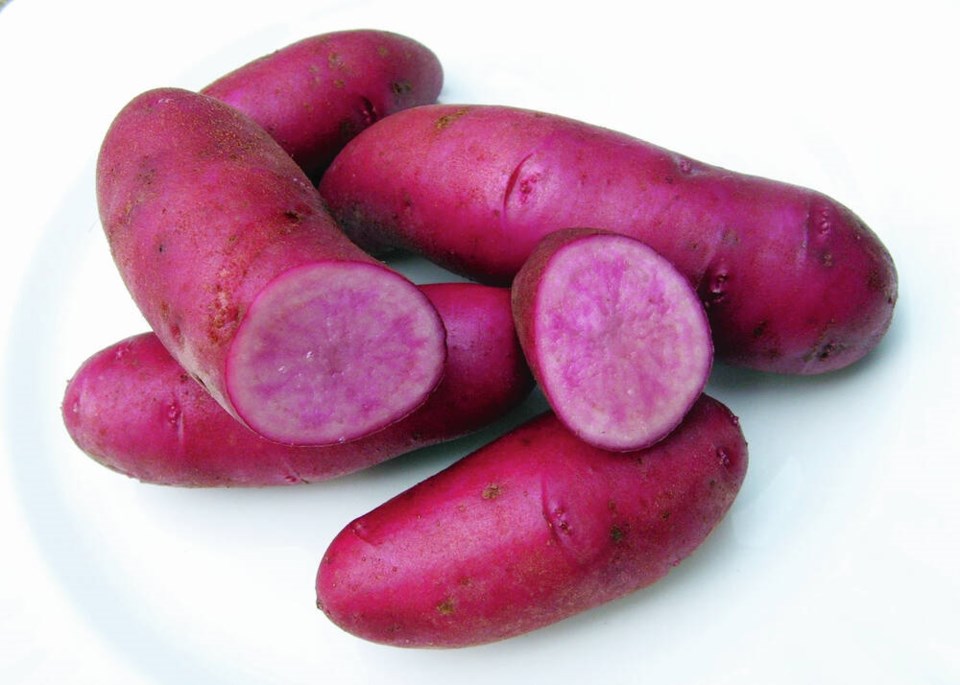Dear Helen: Have you heard of, or read about, the Ozette potato, once grown by Indigenous people on their territories prior to colonization, being grown again in British Columbia? I read about it, and wonder where I might purchase seed potatoes of this variety for planting next spring.
A.S.
I had not come across this news item myself, but my son had called my attention to it just before you sent your email inquiring about the Ozette potato.
Tea Creek Farm, an Indigenous food sovereignty and trades training initiative in Kitwanga, has grown these fingerling potatoes. Ozette is described as one of the kinds of potatoes that Indigenous people grew in the coastal areas of what is now British Columbia. It is a fingerling potato, with a nutty, earthy flavour.
The program manager at Tea Creek (teacreek.ca) replied to my inquiry about the possible availability of Ozette seed potatoes, saying that they began with just a couple potatoes and that “It will be many years before we have enough stock to offer to the public.”
Fourth Sister Farm near Dawson Creek is also growing Ozette.
Until these historic, interesting potatoes are available, if it’s an easy-growing fingerling you are after, try AmaRosa, a delicious, red-fleshed fingerling. Seed potatoes of this variety are usually available at garden centres in the spring.
Dear Helen: This year, for the first time, I grew the climbing zucchini called Tromboncino. Only one, immense fruit grew. Others started growing a bit and then died. I’m not sure how I’ll ever eat that one, huge zucchini.
W.L.
Tromboncino is an Italian summer squash that can grow to 1.2 metres long, with a small seed cavity at the far (blossom) end. It grows on vigorous vines.
The photo that came with your email shows a typical fruit, but one that has passed its prime and has turned yellow. For the best flavour, and to keep more fruits coming along, Tromboncino should be harvested when the fruits are young, still green, and tender.
Squash fruits that begin to form and then shrivel and drop off the plants have not been pollinated, for a lack of pollinating insects or because of generally unfavourable growing conditions.
Your Tromboncino squash remains edible. Use it as you would zucchini or winter squash. Steam cubes of the flesh tender. Add it to soups, pot pies and stews. Make a flavourful puree by sauteeing it with onion and garlic before adding broth or water, cooking everything tender and blending it smooth with an immersion blender. Freeze in containers. For soup in winter, heat the puree with milk or cream.
Dear Helen: We planted our garlic at the beginning of October, in dry, sandy soil, with a mulch layer of straw over top. Green shoots are now coming through the straw. Was the warm, dry weather the problem? What should we do? We don’t want to lose the crop.
B.R.
First, check that the green shoots are garlic, and not seeds sprouting from the straw. Most straw is relatively seed-free, but I’ve purchased a few ales and bags of straw that have sprouted a fair amount of green growth.
If the garlic has begun to sprout, so soon after planting, all you can do now is make sure the soil is kept well dampened. Many home gardeners, like you, planted at their usual time, anticipating the early autumn showers and cooling temperatures that have always faithfully appeared in September or early October, until now. Who knew how long the drought and summer-like temperatures would persist? Most garden soils were warm and dry through mid-October.
I’m taking this very odd autumn as a lesson for next year: No matter my preferred planting time, I’ll be waiting until the soil is well cooled and thoroughly dampened before planting garlic.
GARDEN EVENT
View Royal meeting. The View Royal Garden Club will meet this evening (Wednesday, Oct. 26), at 7:30 p.m. in Wheeley Hall behind Esquimalt United Church, 500 Admirals Rd. Entrance is off Lyall Street. Liz Dick of Special Effects Flowers will speak about growing flowers that are different from most found in garden centres. Her website (specialeffectsflower.com) tells how she got started. A judged mini show will feature exhibits from members gardens. Everyone welcome. Non-member drop-in fee $5. viewroyalgardenclub.wordpress.com.



